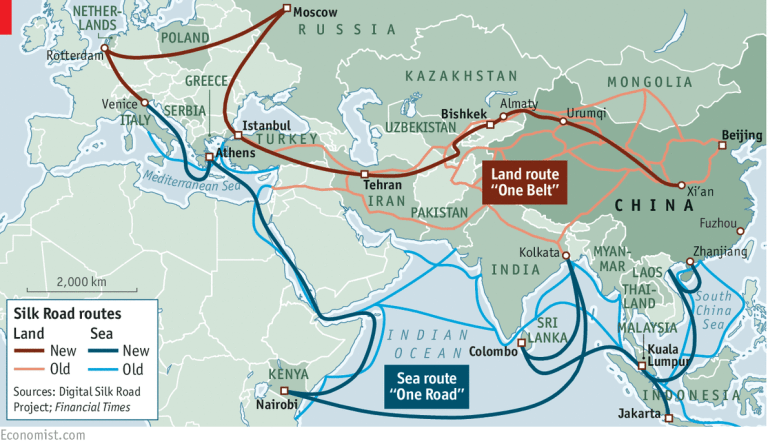The importance of the New Silk Road to the V4 in the global economic space
EnglishIn the future, the V4, as major participants in the 16+1 cooperation, can position themselves as a bridge linking the EU with China with an adequate common strategy.
In the 21st century, centres of economic power, rivalling for global economic power, seek to build as complex and global connectivity as possible and extend it over the world. One of the „players” of this competition for interconnectivity is the BRI (Belt and Road Initiatives), designed by China.
China’s President Xi Jinping launched his mega-project, the „One Belt, One Road” initiative as an international economic recovery programme in 2013. The major aim of the New Silk Road is to develop ever closer economic, political and cultural ties between BRI countries through the development of maritime and overland infrastructure relationships, and to implement Eurasian interconnectivity under China’s leadership. In this BRI project, great value can be attached to the role of the V4 countries, due to their geostrategic location.
Hungary and all V4 countries have been building increasingly intensive relationships with China since the 2000s, which has been further fostered by the fact that the V4 lie on the New Silk Road between Europe and Asia. The V4 states are one of the destinations of the central overland route and a part of the southern railway line, to which also the Maritime Silk Road is connected.
The role of the V4 could be a linking activity, which may include providing transport routes and railway lines as well logistics, and on the other hand, an intermediary activity between the west and the east, with financial and business services.
In order for the V4 countries to become a geopolitically decisive bridge region, integration between them must be enhanced, which would also enable them to lead the future of the CEE region into a competitive direction – says Marcell Horváth, from the Pallas Athéné Innovation and Geopolitical Foundation (PAIGEO) in his recent study in the HUG (Hungarian Geopolitics) magazine.
 The V4 countries have a prominent role in the 16+1 cooperation platform. This is contributable to, on the one hand, their EU membership and their geostrategic locations, which is partly central in terms of the region, and partly frontier in terms of the EU.
The V4 countries have a prominent role in the 16+1 cooperation platform. This is contributable to, on the one hand, their EU membership and their geostrategic locations, which is partly central in terms of the region, and partly frontier in terms of the EU.
The prominent role within the 16+1 is contributable to, on the other hand, their bilateral economic relationships with China. Trade with the V4 countries accounts for 70 percent of the total trade volume between China and the 16 CEE countries.
Approximately 70 percent of total Chinese FDI is directed to the V4 countries, thus the V4 group is the most important area of the 16+1 cooperation in trade and investments.
With regard to the fact that in addition to trade and investments, geographical location, or more precisely, the resulting access to the EU market, plays a key role in international relations with China, the V4 countries’ role in China’s system of foreign relations with the CEE countries has the greatest weight.
However, as long as V4 countries are competing with each other while seeking to establish as favourable cooperation with China as possible for themselves individually, the V4-led CEE region cannot be globally competitive for China.
Out of pragmatic considerations, China seeks cooperation with larger regions. That is why the 16+1 cooperation of diverse CEE countries, which is easier to grasp on a Chinese scale, has been established, the disadvantage of this loose cluster derives exactly from this wide-reaching diversity.
Therefore, an interest of all parties may lie in establishing cooperation within the region at least on V4 level, ensuring economic and infrastructural links, which may become an integral part of the BRI.
A „win-win-win” situation could be created, which can be beneficial for the V4 countries individually, the V4 group, and China.
